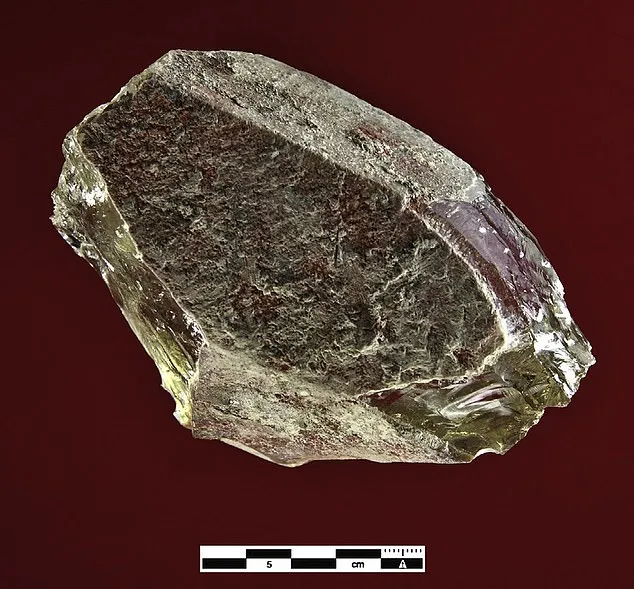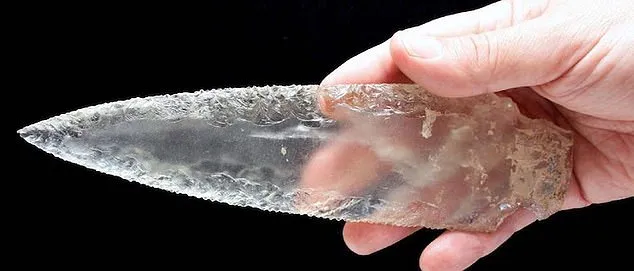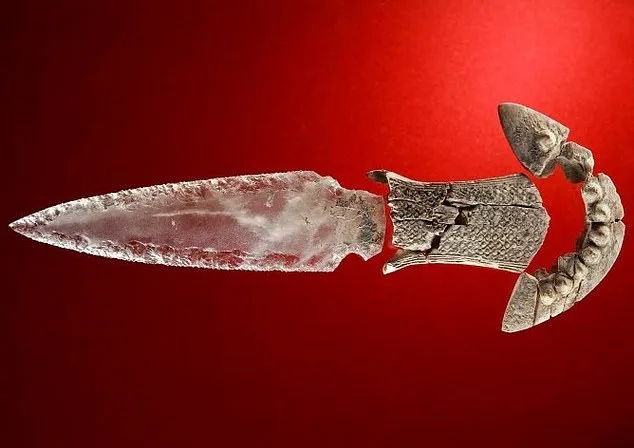This is a 5,000-year-old Crystal dagger discovered in a megalithic tomb in present-day Spain
Ancient tools that once belonged to prehistoric civilizations have been found all over the world, but a discovery in Spain is unlike those traditionally made of stone or flint.

A team excavating the megalithic tomb of Montelirio tholos in 2007 through 2010 uncovered a dagger formed from rock crystal that experts say is the ‘most technically sophisticated’ ever to be uncovered in Prehistoric Iberia and would have taken enormous skill to carve.
The artifact, which is about 5,000 years old, is nearly 8.5 inches long and was found along with 10 arrowheads, four blades and a core for making weapons, all of which were rock crystal.
The weapon’s final resting place is far from crystal mines, which suggests they once belonged to an elite individual who paid a hefty price to have the materials sourced and shaped.
Researchers also speculate that rock crystal during this time may have had a symbolic significance and such societies used it for vitality, magical powers and connections with ancestors.
A team excavating the megalithic tomb of Montelirio tholos in 2007 through 2010 uncovered a dagger formed from rock crystal that experts say is the ‘most technically sophisticated’ ever to be uncovered in Prehistoric Iberia and would have taken enormous skill to carve
‘They probably represent funerary paraphernalia only accessible to the elite of this time-period,’ reads the study published in the journal Quaternary International.
‘The association of the dagger blade to a handle made of ivory, also a non-local raw material that must have been of great value, strongly suggests the high-ranking status of the people making use of such objects.’
The excavation in southwester Spain was a collaboration of researchers from the University of Granada, the University of Seville and the Spanish Higher Research Council.
The teams worked at the site from 2007 through 2010, and published their findings in 2015 that details the trove of crystal weapons.

The stunning dagger was designed to fit an ivory handle (pictured). Experts say it probably belonged to a person of wealth, as the materials were available in places far from this part of Spain
The weapon’s face was polished, which may have been done to avoid fractures or accidents while constructing the shape. Due to the dagger’s size, researchers speculate it was taken from a monocrystal at least eight inches long and two inches thick,
The tomb is located in the lower Guadalquivir valley that sits within the metropolitan area of Seville – the settlement is called ‘Valencina de la Concepcion Castilleja de Guzman.’

Valencina is revered as the most significant site from Copper Age Iberia and is also the largest.
Researchers uncovered rock crystals in eight different sectors of the massive 143-foot long structure that features a 128-foot long corridor leading to a main chamber that is more than 15 feet in diameter.
Although rock crystals were found throughout the site, the most sophisticated items – arrow heads and dagger blade – were uncovered in the southern sector.

Researchers uncovered rock crystals in eight different sectors of the massive 143-foot long structure that features a 128-foot long corridor leading to a main chamber that is more than 15 feet in diameter
Rock crystal arrowheads were also found in the tomb. The arrow heads, 16 in total, were made by pressure-knapping, which is a process that involves removing narrow flakes from along the edge of the stone
Researchers say the arrowheads mimic the look of flint arrowheads, but note greater skill was required to forge such items from crystal
The stunning dagger blade was discovered in the south region of the inner chamber and is rarely found among in Late Neolithic and Copper age burials.
‘The manufacture of the rock crystal dagger must have been based on an accumulation of transmitted empirical knowledge and skill taken from the production of flint dagger blades as well from know-how of rock-crystal smaller foliaceous bifacial objects, reads the study.
The weapon’s face was polished, which may have been done to avoid fractures or accidents while constructing the shape.
Due to the dagger’s size, researchers speculate it was taken from a monocrystal at least eight inches long and two inches thick, and was designed to fit with an ivory handle.
A core for making weapons was also found in the tomb. Along with the weapons, the tomb held the remains of 25 individuals with several woman and one man that are believed to have died due to poisoning
The arrow heads, 16 in total, were made by pressure-knapping, which is a process that involves removing narrow flakes from along the edge of the stone.
Researchers say they mimic the look of flint arrowheads, but note greater skill was required to forge such items from crystal.
Along with the weapons, the tomb held the remains of 25 individuals with several woman and one man that are believed to have died due to poisoning.
The remains were scattered throughout the site, along with grave goods including elephant tusks, jewelry, pots and one ostrich egg was also found.






